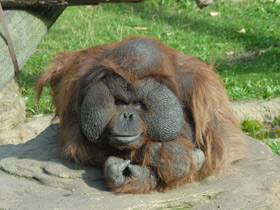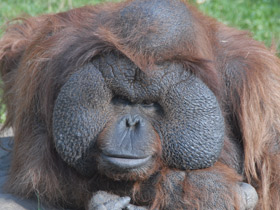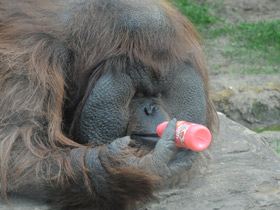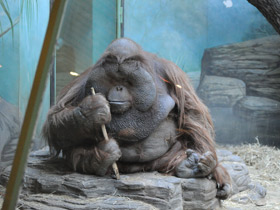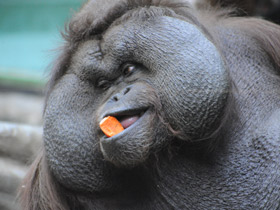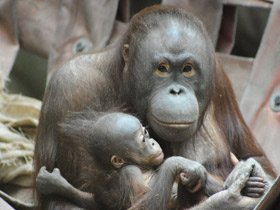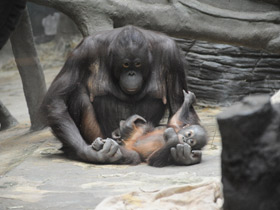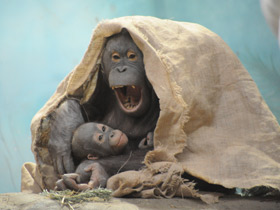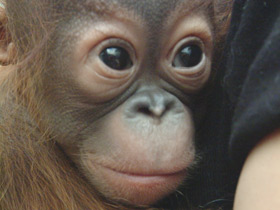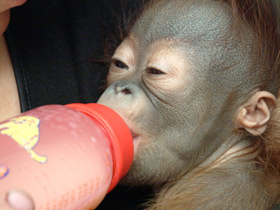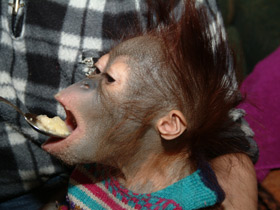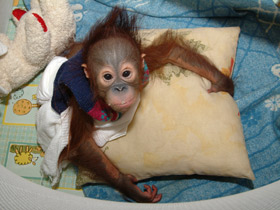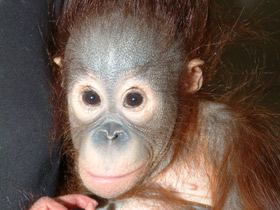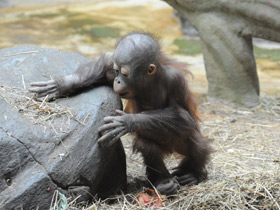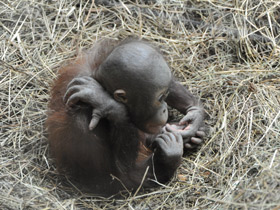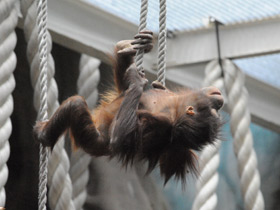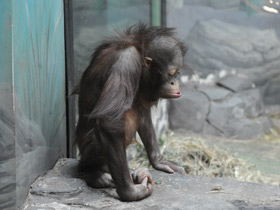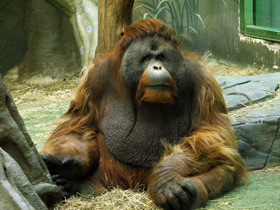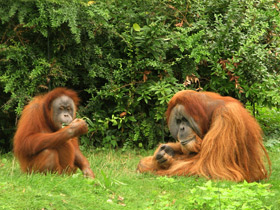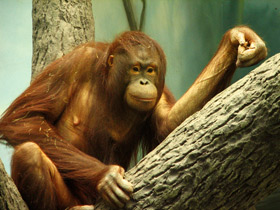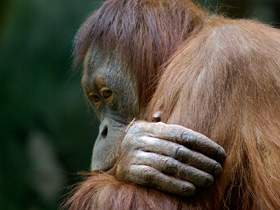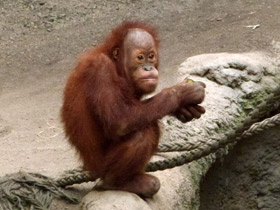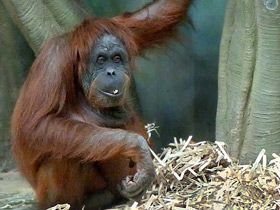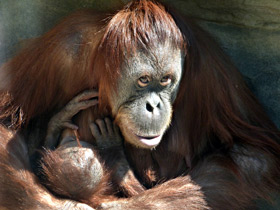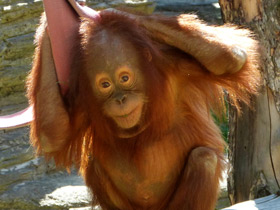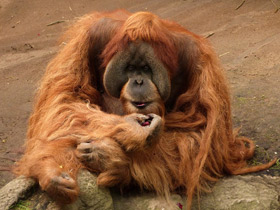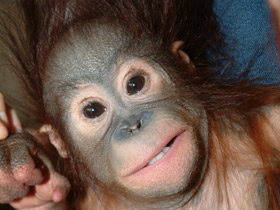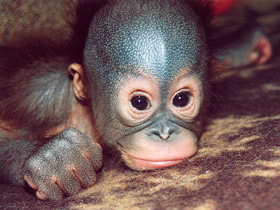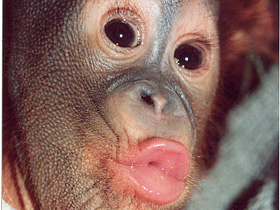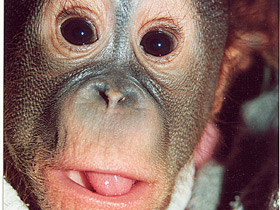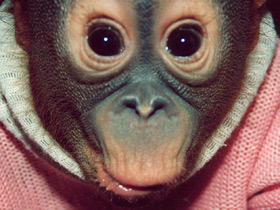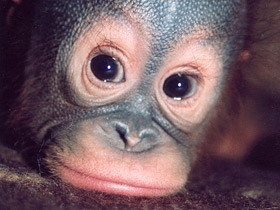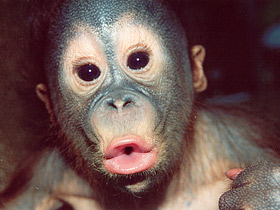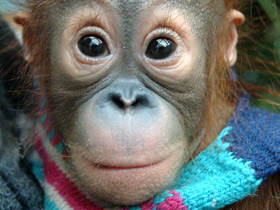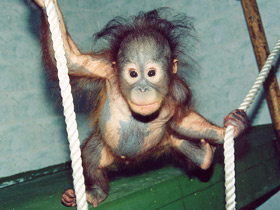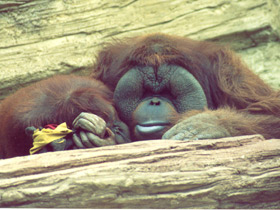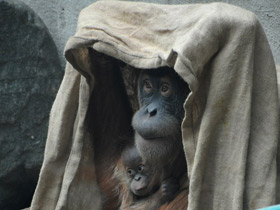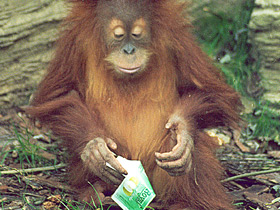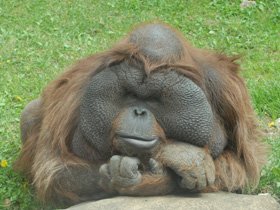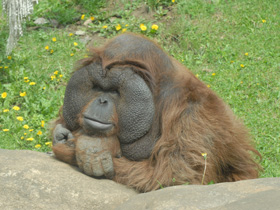The Bornean orangutan (Pongo pygmaeus)
 The Bornean orang-utan (Pongo pygmaeus) is included in the IUCN Red List as an "endangered species"
The Bornean orang-utan (Pongo pygmaeus) is included in the IUCN Red List as an "endangered species"
The Bornean orangutan (Pongo pygmaeus) is a species of orangutan endemic to the island of Borneo. Together with the Sumatran orangutan (Pongo abelii) and Tapanuli orangutan (Pongo tapanuliensis), it belongs to the only genus of great apes native to Asia. It is the largest of the three species of orangutans. Like the other great apes, orangutans are highly intelligent, displaying tool use and distinct cultural patterns in the wild. Orangutans share approximately 97% of their DNA with humans. Also called mias by the local population, the Bornean orangutan is a critically endangered species, with deforestation, palm oil plantations, and hunting posing a serious threat to its continued existence.
Taxonomy
The Bornean orangutan and the Sumatran orangutan diverged about 400,000 years ago, with a continued low level of gene flow between them since then. The two orangutan species were considered merely subspecies until 1996; they were elevated to species following sequencing of their mitochondrial DNA.
The Bornean orangutan has three subspecies:
- Northwest Bornean orangutan Pongo pygmaeus pygmaeus – Sarawak (Malaysia) and northern West Kalimantan (Indonesia).
- Central Bornean orangutan Pongo pygmaeus wurmbii – Southern West Kalimantan and Central Kalimantan (Indonesia).
- Northeast Bornean orangutan Pongo pygmaeus morio – East Kalimantan (Indonesia) and Sabah (Malaysia).
There is some uncertainty about this, however. The population currently listed as Pongo pygmaeus wurmbii may be closer to the Sumatran orangutan (Pongo abelii) than to the Bornean orangutan. If this is confirmed, Pongo abelii would be a subspecies of Pongo wurmbii (Tiedeman, 1808). In addition, the type locality of Pongo pygmaeus has not been established beyond doubt; it may be from the population currently listed as Pongo wurmbii (in which case Pongo wurmbii would be a junior synonym of Pongo pygmaeus, while one of the names currently considered a junior synonym of Pongo pygmaeus would take precedence for the taxon in Sarawak and northern West Kalimantan). Bradon-Jones et al. considered Pongo morio to be a synonym of Pongo pygmaeus, and the population found in East Kalimantan and Sabah to be a potentially unnamed separate taxon.
Physical description
The Bornean orangutan is the third-largest ape after the western gorilla, and the largest truly arboreal (or tree-dwelling) extant ape. Body weights broadly overlap with the considerably taller Homo sapiens, but the latter is considerably more variable in size. By comparison, the Sumatran orangutan is similar in size but, on average, is marginally lighter in weight. A survey of wild orangutans found that males weigh on average 75 kg (165 lb), ranging from 50–100 kg (110–220 lb), and 1.2–1.7 m (3.9–5.6 ft) long; females average 38.5 kg (85 lb), ranging from 30–50 kg (66–110 lb), and 1–1.2 m (3.3–3.9 ft) long. While in captivity, orangutans can grow considerably overweight, up to more than 165 kg (364 lb). The heaviest known male orangutan in captivity was an obese male named "Andy", who weighed 204 kg (450 lb) in 1959 when he was 13 years old.
The Bornean orangutan has a distinctive body shape with very long arms that may reach up to 1.5 metres in length. It has grey skin, a coarse, shaggy, reddish coat and prehensile, grasping hands and feet. Its coat does not cover its face unlike most mammals, although Bornean orangutans do have some hair on their faces including a beard and mustache. It also has large, fatty cheek pads known as flanges as well as a pendulous throat sac.
Bornean orangutans are highly sexually dimorphic and have several features that differ between males and females. Males have much larger cheek pads, or flanges, that are composed of muscle and large amounts of fat. In females, the flanges are mostly composed of muscle. Males have relatively larger canines and premolars. Males have a more pronounced beard and mustache. The throat sac in males is also considerably larger. There are two body types for sexually mature males: smaller or larger. Larger males are more dominant but smaller males still breed successfully. There is little sexual dimorphism at birth.
Habitat and distribution
The Bornean orangutan lives in tropical rain forests in the Bornean lowlands, as well as montane rain forests in mountainous areas up to 1,500 metres (4,900 ft) above sea level. This species lives throughout the canopy of primary and secondary forest, and moves large distances to find trees bearing fruit.
It is found in the two Malaysian states of Sabah and Sarawak, and four of the five Indonesian Provinces of Kalimantan. Due to habitat destruction, the species distribution is now highly patchy throughout the island, the species has become rare in the southeast of the island, as well as in the forest between the Rajang River in central Sarawak and the Padas River in western Sabah. Its presence in Brunei is uncertain and unconfirmed.
The first complete orangutan skeleton that was discovered was in the Hoa Binh province in Vietnam and thought to be from the late Pleistocene epoch. It differed from modern orangutans only in that its body was proportionately smaller compared to its head. This fossil and others confirm that orangutans once inhabited continental Southeast Asia even though currently, Bornean orangutans are only found in Malaysia and Indonesia.
Behavior and ecology
In history, orangutans ranged throughout Southeast Asia and into southern China, as well as on the island of Java and in southern Sumatra. They primarily inhabit peat swamp forest, tropical heath forest, and mixed dipterocarp forest. Bornean orangutan are more solitary than their Sumatran relatives. Two or three orangutans with overlapping territories may interact, but only for short periods of time. Although orangutans are not territorial, adult males will display threatening behaviors upon meeting other males, and only socialize with females to mate. Males are considered the most solitary of the orangutans. The Bornean orangutan has a lifespan of 35–45 years in the wild; in captivity it can live to be about 60.
Despite being arboreal, the Bornean orangutan travels on the ground more than its Sumatran counterpart. This may be in part because no large terrestrial predators could threaten an orangutan in Borneo. In Sumatra, orangutans must face predation by the fierce Sumatran tiger.
The Bornean orangutan exhibits nest-building behavior. Nests are built for use at night or during the day. Young orangutans learn by observing their mother's nest-building behaviour. This skill is practiced by juvenile orangutans. Nests may be elaborate and involve a foundation and mattress made by intertwining leaves and branches and adding broken leafy branches. Additional features such as shade, waterproof roof, "pillow", and "blanket", all of which are made from branches, twigs and leaves, may also be added. Nest-building in primates is considered as an example of tool use and not animal architecture.
Diet
The Bornean orangutan diet is composed of over 400 types of food, including wild figs, durians (Durio zibethinus and D. graveolens), leaves, seeds, bird eggs, flowers, sap, vines, honey, fungi, spider webs, insects, and, to a lesser extent than the Sumatran orangutan, bark. They have also been known to consume the inner shoots of plants and vines. They will also occasionally eat nutrient rich soil. They get the necessary quantities of water from both fruit and from tree holes.
Bornean orangutans have been sighted using spears to attempt (unsuccessfully) to catch fish. The species has been observed using tools such as leaves to wipe off faeces, a pad of leaves for holding spiny durian fruit, a leafy branch for a bee swatter, a bunch of leafy branches held together as an "umbrella" while traveling in the rain, a single stick as backscratcher, and a branch or tree trunk as a missile. In some regions, orangutans occasionally eat soil to get minerals that may neutralize the toxins and acids they consume in their primarily vegetarian diets. On rare occasions, orangutans will prey upon other, smaller primates, such as slow lorises.
Reproduction
Males and females generally come together only to mate. Subadult males (unflanged) will try to mate with any female and will be successful around half the time. Dominant flanged males will call and advertise their position to receptive females, who prefer mating with flanged males. Adult males will often target females with weaned infants as mating partners because the female is likely to be fertile.
Females reach sexual maturity and experience their first ovulatory cycle between about six and 11 years of age, although females with more body fat may experience this at an earlier age. The estrous cycle lasts between 22 and 30 days and menopause has been reported in captive orangutans at about age 48. Females tend to give birth at about 14–15 years of age. Newborn orangutans nurse every three to four hours, and begin to take soft food from their mothers' lips by four months. During the first year of its life, the young clings to its mother's abdomen by entwining its fingers in and gripping her hair. Offspring are weaned at about four years, but this could be much longer, and soon after they start their adolescent stage of exploring, but always within sight of their mother. During this period, they will also actively seek other young orangutans to play with and travel with. On average, juveniles do not become completely independent until they are about seven years of age. The birth rate for orangutans has been decreasing largely due to a lack of sufficient nutrients as a result of habitat loss.
A 2011 study on female orangutans in free-ranging rehabilitation programs found that individuals that were supplemented with food resources had shorter interbirth intervals, as well as a reduced age, at first birth.
Conservation status
The Bornean orangutan is more common than the Sumatran, with about 104,700 individuals in the wild, whereas just under 14,000 Sumatran orangutans are left in the wild. Orangutans are becoming increasingly endangered due to habitat destruction and the bushmeat trade, and young orangutans are captured to be sold as pets, usually entailing the killing of their mothers.
The Bornean orangutan is critically endangered according to the IUCN Red List of mammals, and is listed on Appendix I of CITES. The total number of Bornean orangutans is estimated to be less than 14% of what it was in the recent past (from around 10,000 years ago until the middle of the 20th century), and this sharp decline has occurred mostly over the past few decades due to human activities and development. Species distribution is now highly patchy throughout Borneo; it is apparently absent or uncommon in the southeast of the island, as well as in the forest between the Rajang River in central Sarawak and the Padas River in western Sabah (including the Sultanate of Brunei). A population of around 6,900 is found in Sabangau National Park, but this environment is at risk.
Photos 1-5 - males.
Photos 6-8 - females with cubs.
Photos 9-13 - a baby orang-utan that was abandoned by its mother and fed by zoo staff.
Subspecies
- Pongo pygmaeus morio;
- Pongo pygmaeus pygmaeus pygmaeus;
- Pongo pygmaeus pygmaeus wurmbii.

















